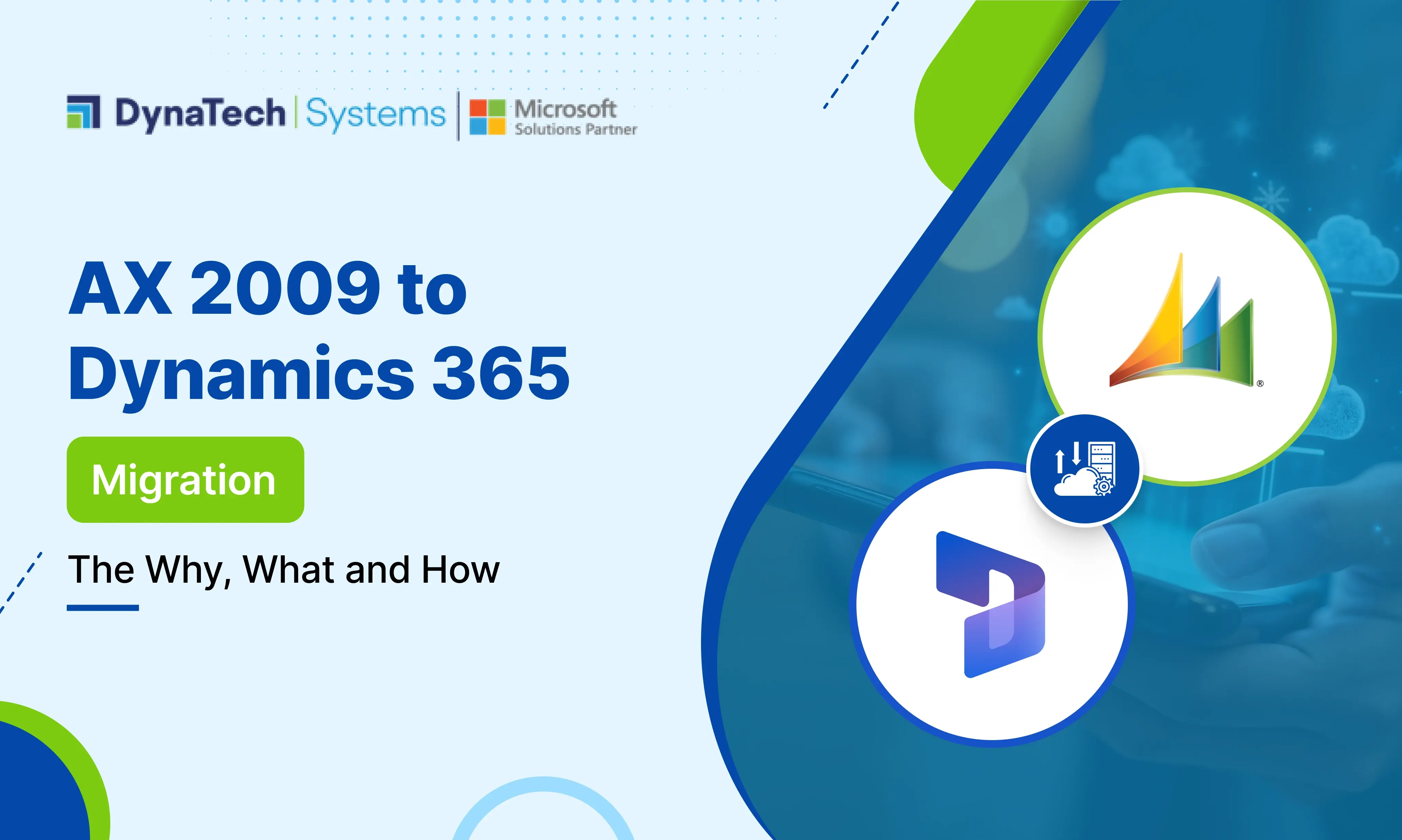There's no denying it: Microsoft Dynamics AX 2009 has had a solid run. For over a decade, it powered operations rationalized finances and helped countless businesses grow. But in today's fast-moving, cloud-first economy, legacy isn't a badge of honor—it's a bottleneck.
As market dynamics shift and customer expectations rise, the cost of staying on AX 2009 isn't just technical—it's strategic. From compliance blind spots and disconnected data to rising support overheads, holding onto an aging ERP system can quietly eat into productivity and profits.
That's the reason why the move from AX 2009 to Dynamics 365 isn't just another IT project—it's a business reinvention. With the ideal strategy and execution, the AX 2009 to D365 upgrade can help discover real-time insights, process automation, AI-driven forecasting, and global scalability.
In this blog, we help you explore everything you need to know about the AX 2009 to Dynamics 365 migration—why it matters now more than ever, what hurdles to expect, the long-term value it delivers, and how to chart a smooth path forward with a reliable Microsoft Solutions Partner.
Why Now? The Strategic Imperative Behind AX 2009 to Dynamics 365 Migration
What worked brilliantly a decade ago isn't built to deal with today's digital complexity. Microsoft Dynamics AX 2009 may have once been the backbone of your operations, but the technological environment it was created for no longer exists.
We're operating in a hyper-connected, always-on, data-first economy. Decisions need to be made in no time, compliance requirements are tighter, and customer expectations are higher. In this new era, relying on a legacy ERP like AX 2009 is like trying to stream 4K video on dial-up—it's simply outpaced.
Here's why the case for AX 2009 to Dynamics 365 migration is no longer an option to try out—it's an indispensable move to sustain:
1. End of Support Is More Than an IT Issue—It's a Business Risk
AX 2009 is out of both mainstream and extended support. That means no more vital updates, no bug fixes, and, most importantly—no security patches. In today's cyber landscape, that's a risk most organizations can't afford to take. Compliance frameworks demand up-to-date infrastructure. Running AX 2009 puts you at immediate regulatory and reputational risk.
2. On-Prem Infrastructure is a Sinking Cost Center
Maintaining AX 2009 on-premise isn't just cumbersome—it's costly. Hardware upgrades, database tuning, server management, backups—these hidden IT costs stack up faster. Dynamics 365 Finance and Operations, being cloud-native, offers a secure, scalable, and high-performing environment while helping businesses get rid of infrastructure overheads.
3. Your Growth Is Being Throttled
Whether you're expanding into new geographies or scaling product lines, AX 2009 was not designed with worldwide agility in mind. It struggles with increasing demands like real-time reporting, multi-entity visibility, and API-driven integration. Dynamics 365, in contrast, offers hassle-free scalability and unified operations—on a global scale.
4. Intelligence Isn't Optional Anymore
In the age of AI, data isn't merely a byproduct—it's a strategic asset. However, AX 2009 has no embedded analytics, predictive insights, or automation. On the other hand, Dynamics 365 F&O equips your teams with built-in AI, machine learning, and smart reporting through Power BI—turning data into a competitive advantage.
Understanding the Shift: What Really Changes When You Move to Dynamics 365
The leap from Dynamics AX 2009 to Dynamics 365 Finance & Operations isn't just a technical migration—it's a complete reimagining of what your ERP can do. Where AX 2009 was created for stability, Dynamics 365 is engineered for intelligence, speed, and scale.
Let's break down the most impactful shifts across key business areas:
|
Feature Area |
Dynamics AX 2009 |
Dynamics 365 F&O |
|
Deployment |
Traditional on-premises model |
Fully cloud-based with the flexibility of on-prem or hybrid options—ideal for global, distributed teams |
|
UI/UX |
Outdated, monolithic interface |
Modern, intuitive, role-based workspaces designed for productivity and collaboration |
|
Reporting |
Dependent on SSRS with heavy manual input |
Real-time analytics, embedded Power BI, and visual dashboards available on demand |
|
Integration |
Limited API capabilities |
Seamless interoperability with Microsoft 365, Azure, Power Platform, and 3rd-party solutions |
|
Updates |
Infrequent and complex manual upgrades |
Automated, continuous updates delivered by Microsoft—no downtime, no disruption |
|
AI & Automation |
Virtually nonexistent |
Built-in AI, machine learning, and intelligent automation for smarter decision-making and process efficiency |
AX 2009 to D365 Upgrade: A Proven Step-by-Step Migration Approach
Upgrading from AX 2009 to Dynamics 365 is more than a technical shift—it's a strategic transformation. Here's an effective guide to upgrading from AX 2009 to Dynamics 365 Upgrade:
Step 1: Assessment & Strategic Roadmapping
Every successful migration starts with clarity. Let's begin by conducting a deep-dive AX 2009 system assessment to map where you are—and where you require to be.
- Extensive audit of your existing AX 2009 environment
- Evaluation of customizations, ISV solutions, and third-party integrations
- Identification of unnecessary processes and opportunities for reengineering
- Alignment of Dynamics 365 capabilities with your business goals
This sets the foundation for a migration plan that's personalized—not templated.
Step 2: Data Strategy & Governance
When migrating from AX 2009 to Dynamics 365, not all data should make the journey. Use your data to make smart decisions.
- Segmentation and classification of historical vs. operational data
- Cleansing, deduplication, and enrichment of existing datasets
- Structured data migration planning—phased or big bang
- Built-in compliance protocols for industry-specific regulations
This ensures the data you bring into Dynamics 365 F&O is clean, relevant, and fully governed.
Step 3: Process Optimization, Not Just Replication
Rather than simply replicating legacy workflows, grab an opportunity to modernize and streamline operations.
- Leverage native Dynamics 365 Finance & Operations best practices
- Enforce Power Platform-based automation to eradicate manual steps
- Infuse AI capabilities for advanced financial forecasting, demand planning, and process automation
This is where businesses start experiencing real efficiency gains, even before going live.
Step 4: Execution with Precision
Armed with the robust tools and frameworks—including Microsoft Lifecycle Services (LCS) and Data Management Framework (DMF)—it's time to move to structured execution.
- Code uplift or refactoring (if applicable)
- Controlled data migration with parallel validation
- Extensive performance testing and simulation of live scenarios
- Environment configuration aligned to production readiness
Each phase is tracked, logged, and reviewed to eliminate surprises.
Step 5: Enablement, Training & Change Management
Technology alone doesn't drive transformation—people do. That's why it's important to place a strong emphasis on change enablement.
- Role-based training programs customized to multiple user personas
- Guided walkthroughs and process simulations
- Hands-on user acceptance testing (UAT)
- Go-live readiness workshops, followed by post-launch hyper care
This ensures your teams are confident, capable, and absolutely prepared to thrive in the Dynamics 365 environment.
Key Benefits of Migrating to Dynamics 365 Finance & Operations
Moving from AX 2009 to Dynamics 365, F&O delivers instant business value—modernizing how your organization operates and grows.
- Real-Time Insights: Get instant visibility into financials and operations with embedded analytics and Power BI, enabling quicker, data-led decisions.
- Global Compliance & Scalability: Operate confidently across regions with built-in support for global tax, currency, and regulatory requirements.
- Agile, Future-Ready Platform: Rapidly adapt to modern business requirements, deploy features, and scale operations without complex upgrades or downtime.
- Boosted Productivity: Automated workflows, AI suggestions, and effortless Microsoft 365 integration free teams from manual tasks.
- Lower IT Costs: Say Ciao to hardware, upgrades, and maintenance—cloud-based infrastructure dramatically cuts ongoing costs.
With a successful AX 2009 to Dynamics 365 migration, your ERP becomes a driver of innovation, not a barrier to it.
Concluding Statement: Moving from Legacy to Leadership
AX 2009 served its time—but modern business demands more. Migrating to Dynamics 365 F&O isn't just about upgrading software; it's about discovering agility, intelligence, and future-ready operations.
The businesses that act now will outpace change. Those that don't risk being outpaced by it. The choice isn't just technical—it's strategic.




























